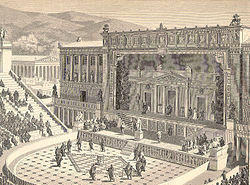Poetry
Homer featured people trying to live up to standards of courage and honor. Pindar wrote poems that honoured sports heroes. Sappho wrote of friendship and love.
Drama
Poems evolved to songs and finally to drama when Thespis broke away and spoke lines on his own. Plays were a big deal to the Athenians. On opening day even prisoners were let out to attend.
Tragedies
The Greek tragedies were plays that showed dignity in the face of trouble. They showed how noble people could be. The Universe was governed by fate or destiny in these plays. People who were too stubborn or proud would be punished by destiny. Aeschylus, Sophocles, and Euripides wrote some of the great tragedies.
Comedies
The comedies of Aristophanes and others were satires of politics and current events. History The Athenians were the first to examine history with a critical eye. Herodotus and Thucydides were some of the historians of the day. Artists and Architects Paintings and sculptures showed the ideal person. The Athenians tried to make structures fit with natural surroundings. E.G: the Parthenon seems to grow up out of the rocks.
 |
| Parthenon |
Philosophy
Philosophy is the love of wisdom. The Greek philosophers started with deep-seeded questions such as: "Why are humans here?" and "How far is the universe?" Greeks looked for rational ways to explain the natural world. They believed in natural laws, many of which were wrong.
Pythagorus
Pythagorus believed the universe was arranged according to natural laws. He discovered the Pythagorean Theorem, the relationship between the sides of a right triangle.
Hypocrites
Hypocrites started a medical school and taught people to find the reason for illnesses. He separated medicine from magic.
Socrates 469-399 BC
Socrates never wrote anything down. He believed that it was more important to gain knowledge of human beings than to investigate nature. He thought that one should get knowledge from reason, not emotions. "The unexamined life is not worth living." He taught by having discussions in which the truth of every statement was questioned. Socrates was killed for his ideas.
Plato 427 - 347 BC
Plato was a student of Socrates. He believed that laws must serve the best interests of everyone. He blamed democracy for the troubles in Greece because too few had the brains to govern wisely. Plato wanted philosopher kings.
Aristotle 384 - 322 BC
Aristotle studied everything (plants, animals, and astronomy). He was the founder of science and biology. Aristotle analyzed speech to see what made for effective speeches.
Thermopylae
"These men have come to fight us for the possession of the pass, and for that struggle they are preparing. It is the common practice of the Spartans to pay careful attention to their hair when they are about to risk their lives. But I assure you that if you can defeat these men and the rest of the Spartans, there is no other people in the world who will dare to stand firm or lift a hand against you. You have now to deal with the finest kingdom in Greece, and with the bravest men."
"The Persians had in their army many men, but few soldiers."
There are many interesting culture difference as its very artist and creative in Athens and it’s a great atmosphere. It’s a highlight to be able to walk around and feel the creativeness of artists etc flowing J








